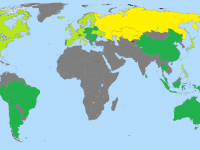Monsters
There are monsters under my bed. When I was a child, I could sense them in every half-seen shadow, feel their breath on my neck. I knew monsters were imaginary. But I was still afraid.
I am a non-binary larper. Time and again, I find that larps are framed to create those shadowy spaces and summon monsters. Monsters hiding under the bed and in the closet, but much more real and able to harm me.
Most of my fellow larpers are lovely people who don’t intend their games to include monsters. They are happy to fight the big and dangerous monsters. But many of the monsters I fight are sneakier; they keep themselves invisible to well-meaning allies.
This is a guide to some of the monsters that non-binary adventurers encounter when they larp. If you are non-binary, you might recognise them and know you are not alone in your fight. If you are not, then I hope you can use this as a spotter’s guide to help you check your games to see if you might be creating fertile ground for monsters to spawn.

Basilisk, illustration by Marcus Irgens
Basilisk: This snake-like creature can petrify or kill with a glance. It is common in larps to find that a Basilisk has wiped all non-binary people from the game world. Non-binary adventurers risk petrification from the discomfort and dysphoria of being forced to play a binary gender. Even the reflection of a Basilisk’s gaze can kill: larps based on highly gendered media often mimic source material and exclude non-binary characters, unintentionally perpetuating a problem. The danger can be reduced to a painful skin condition by allowing non-binary characters who are perceived as binary, but beware; this opens you up to a Bogeyman attack.
Kelpie: These river spirits take the shape of a horse, trying to entice would-be riders up onto their back. At larp events, they appeal to players by offering the promise that people can sign up as their own gender – because that’s important to many people. When the non-binary adventurer mounts the Kelpie, it becomes clear that this was a ploy; the Kelpie attempts to drown them in the river by forcing them to sign up as Male or Female. Kelpies can also attack adventurers of sexual or romantic minorities, manifesting as a promise of romance plots that turn out to only be compatible with the sexuality of straight players.
Goblin: These monsters taunt and harry writers, whispering in their ears until they are afraid to include non-binary characters in their game “in case they get it wrong” – even though their larp contains no plots about the characters’ internal sense of gender. Gripped by fear, the writer does not notice that they have written many characters outside their experience, such as androids, giant insects, and humans with a binary gender not their own. While the Goblin’s attack seems subtle, the results are indistinguishable from the attack of a Basilisk. Fooled by the Goblin, the writer does not even think to consult a non-binary adventurer for advice.

Bogeyman, illustration by Marcus Irgens
Bogeyman: This monster lurks in the closet, ready to pull adventurers inside at any sign of gender-transgressing ‘bad behaviour’. If you attend a gendered game and decide to play in a gender non-conforming outfit, such as a woman in trousers – a common armour against dysphoria and often an adventurer’s only clothing – then watch out for this monster causing in-character hostility. This monster exists in larps, but also in many other contexts, and fighting too many becomes exhausting. It is often necessary to make a choice: hide from this monster and suffer the wounds in silence, or face it for yet another painful battle?
Dragon: Like Goblins, Dragons attack imaginations, destroying even the idea of better alternatives. There are numerous types; the non-binary and sexism Dragons like to team up, setting fire to whole cities of imagination so writers see only barren ground. Bereft of inspiration, the writer uses their own world and again chooses gender as the basis for the division of character roles and social dynamics. The resulting highly-gendered game harms AFAB people, but causes extra damage to a non-binary adventurer. The Dragon’s work also causes the GM to almost always cast non-binary adventurers as the gender they were assigned at birth, even when there is a better fitting character in another gender.
Changeling: This monster exists in disguise, often using words like ‘inclusivity’ and ‘feminism’ to create what seems like a welcoming space. Once inside their lair, they reveal their fangs and attack any trans person who enters. These monsters are so insidious because any enticing larp could be a Changeling lair; as a result, their very existence ensures that many an adventurer must distrust any game unless they clearly display support of transgender and non-binary inclusion, behaviour that Changelings usually struggle to mimic.

Minotaur, illustration by Marcus Irgens
Minotaur: These monsters like to hide inside a labyrinth. These can be subtle constructions, taking a while for an adventurer to realise they have been drawn in. While the game contains nothing openly problematic, it also contains no non-binary characters or suggestions for replacement gender dynamics written into the background. This allows the Minotaur to gradually fill in the gaps with its labyrinth, reproducing existing social dynamics and player biases. The adventurer experiences a gradual realisation that they are becoming more lost with every turn, as the distant roaring sound grows ever closer.
Ghost: An adventurer possessed by this monster, becomes invisible. They can wear pronoun badges, deliberately mix gendered clothing and other markers, and correct people’s misuse of their pronouns, but it won’t help – they are treated as binary despite all evidence to the contrary. The more this happens, the tighter the grip of the Ghost. If you are haunted by a Ghost, your only hope is that there are enough psychic players in the game to affirm your characters’ gender until the influence of this monster has been overcome.
Zombie: Zombies are slow and would not be very threatening on their own, but they can destroy an adventurer through sheer relentless numbers. Phrases like ‘ladies and gentlemen’, ‘he or she’, ‘this is a game for women but men are also welcome’, lack of gender-neutral toilets at a venue – these things permeate out of character interactions and they build up until the adventurer becomes worn down from a thousand small wounds.

Nessie, illustration by Marcus Irgens
Nessie: Nessies are mysterious beasts that lurk under the surface of your game. They manifest as social pressure not to make a fuss or drop out of a game, taking advantage of people’s reasonable desire for commitment and natural wish not to spoil things for others. When a Nessie emerges, a person suffering other monster attacks finds their escape cut off by sinewy scales, causing them social damage and increased exclusion if they try to flee. Nessies do not limit their prey; they often attack disabled adventurers or those with mental health conditions to manage.
Counterspells
There are monsters under my bed. When I was a child, I learned to use magic to fire lightning and create a shield. I reasoned this should work because the monsters were also imaginary.
Larps are spells. Larp is where we take our own stories and build new cultures and visions for how the world might be. Through this ritual we take them one step closer to reality.
This is a guide to some counterspells that can arm non-binary adventurers. If you are non-binary, I hope this gives you light and hope. If you are not, I hope you can use this guide to help you write, play, and run larps in ways that help combat the monsters we face daily.

Horn of Plenty, illustration by Marcus Irgens
Horn of Plenty: Just as some monsters team up, so can different adventurers, generating a nurturing feedback loop. Including other queer characters, having non-normative relationships, and combating sexism monsters in larps can invoke the Horn of Plenty, causing a feast of nourishment to flow for all. This effect is enhanced by placing these characters in positions of power; write non-binary heads of house, trans woman ruler in a polyamorous triad, and a pansexual and aromantic Grand Vizier.
Circle of Protection: An adventurer equipped with this spell possesses a magic shield that encircles them and holds back monsters. The Circle of Protection is invoked on the spot using safety words or prior to an adventure by writing a list of lines, and its use empowers an adventurer by offering them control over participating in certain themes and topics.
As Above, So Below: Sympathetic magic makes use of the way that ‘like produces like’, enacting changes in a representation that will also affect the real thing. In a larp, this can be invoked by writing explicitly non-binary or gender non-conforming characters into setting and character backgrounds in ways that deliberately offer new social dynamics and non-gendered roles. This spell can be boosted with subtle details in set dressing: costumes that mess with traditional gendered clothing, feminine motifs in the warrior enclave, masculine motifs at the woolmaking hearth, background music from queer subcultures.
Walking the Ways: An experienced adventurer can learn to slip between the cracks and into the Wild Ways, allowing them to traverse large distances quickly and avoid the monsters lurking there. You can enable this in a larp by calling down some essence of the Ways into your game. Write a game where gender neutrality is the norm; where queerness and gender fluidity is the default assumption; where gender weirdness is celebrated; where characters have different genders or no genders or extra genders.

Talisman of Sky, illustration by Marcus Irgens
Talisman of Sky: Air is a powerful element, one which fuels our breath and is associated with the mind and communication. Allow players to commune with their characters in whatever way their breath and connection takes them. You can invoke this in a larp by writing all characters as gender neutral and allowing players to choose their gender and pronouns. Many writers find this spell difficult to invoke; their minds want to impose their own gender habits, which hampers the Talisman. Think carefully before you gender a character, as almost no plots really require a specific gender identity.
Sigil of Earth: This element of growth and strength can be invoked if Sky is not possible. When writing a larp with pre-set character genders, plant the seeds for this spell by deliberately writing against cultural gender roles and including explicitly non-binary or intersex characters. Gender roles are very ingrained, and writers tend to use their culture’s ideas if they let their feet carry them without conscious intervention. (Try rolling a die after writing each character: 1-4, female; 5, intersex; 6, non-binary; 7-10, male.) When you cast, allow for players willing to play any gender, and do your first pass without knowing their identity and thus name or presentation.
Shadow Dancing: An adventurer can use movement mirroring a monster’s symbolic representation to form a spell that will strip them of their power. At your event, you can dance this by ensuring that procedures are the same for all genders: if game writers must specify the number of male or female characters, also ask how many characters are explicitly non-binary. If players can sign-up as male or female, allow them to sign-up explicitly as non-binary. If your venue has toilets that are provided specifically for men and for women, select one set and make them gender neutral (labelled with urinals or with sanitary bins).
Ritual of Transmutation: No adventurer steps out with immediate mastery of monster hunting skills. This ritual is best reinforced frequently, gradually allowing your powers to grow. This spell is invoked by using non-binary inclusive phrases at least three times in the mirror, with increasing intensity until you feel the spell begin to settle in your bones. Practice turns of phrase, pronouns, and forms of address. Check your writing, and if you’re not sure the spell is working, ask a friendly non-binary adventurer if they have time to look over your work – though adventurers may need to conserve energy for fighting monsters.
True Naming: Knowing someone’s true name grants power – knowing your own, more so. In a larp, you invoke this spell by building norms to always check pronouns, either visually (if there are badges) or verbally. When players sign up, don’t ask what their gender is; ask them instead what gender they would like to play and what pronouns their character should have. In your game, specify that the default pronoun is ‘they’ unless you have checked on a particular character’s pronouns. Use a clear and simple pronoun correction procedure, and have players practice it in a game workshop as they would any other mechanics.

Healing potion, illustration by Marcus Irgens
Healing Potion: This spell is created in advance, combining sacred herbs and hidden fruit in a potion to restore lost vitality. You can create one by taking the time to include Queer histories and media in your source material, supporting non-binary and transgender writers, uplifting LGBTQIA+ players in your community and giving them a voice – and importantly, listening to what they say. Sometimes people feel a shadow of the pain when they encounter a wounded adventurer speaking of their battles, and can unknowingly lash out at the adventurer instead of helping to fight the monster. The best response for you both is to offer the wounded adventurer a healing potion instead
Adventuring
There will always be monsters under the bed. Some of these will be of my own making.
I write and run games. I, too, inadvertently create monsters. As a wizard, I must research the side effects of my choices and try to modify my spellmaking accordingly. If we make an effort, we can perhaps band together as fellow adventurers of all kinds. We can share our spells and our vitality, and create a better fantasy land for all of us.
Will you come adventuring with me, and fight them together?
Cover photo: Image by OpenClipart-Vectors on Pixabay.
This article is published in the companion book Book of Magic: Vibrant Fragments of Larp Practices and is published here with permission. Please cite this text as:
England, Rei. “Magic To Fight Monsters: Larp as a spell for claiming my spaces.” In Book of Magic: Vibrant Fragments of Larp Practices, edited by Kari Kvittingen Djukastein, Marcus Irgens, Nadja Lipsyc, and Lars Kristian Løveng Sunde. Oslo, Norway: Knutepunkt, 2021.






